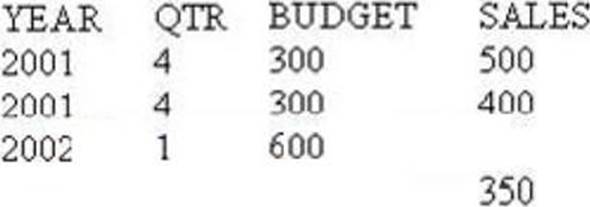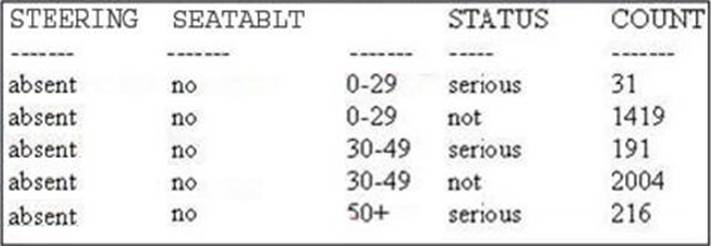SAS Institute A00-212 SAS Advanced Programming Exam for SAS 9 Online Training
SAS Institute A00-212 Online Training
The questions for A00-212 were last updated at Nov 22,2024.
- Exam Code: A00-212
- Exam Name: SAS Advanced Programming Exam for SAS 9
- Certification Provider: SAS Institute
- Latest update: Nov 22,2024
The following SAS program is submitted:
Data sasuser.history;
Set sasuser.history(keep=state x y
Rename = (state=ST));
Total=sum(x, y);
Run;
The SAS data set SASUSER.HISTORY has an index on the variable STATE.
Which describes the result of submitting the SAS program?
- A . The index on STATE is deleted and an index on ST is created
- B . The index on STATE is recreated as an index on ST
- C . The index on STATE is deleted
- D . The index on STATE is updated as an index on ST
The following SAS program is submitted:
%macro one (input);
%two;
%put the value is &date;
%mend;
%macro two;
data _null_;
call symput(‘date’,’12SEP2008′);
run;
%mend;
%let date=31DEC2006;
%one(&date)
What is the result when the %PUT statement executes?
- A . A macro variable DATE with the value 12SEP2008 is retrieved from the local symbol table for the ONE macro
- B . A macro variable DATE with the value 12SEP2008 is retrieved from the local symbol table for the TWO macro
- C . A macro variable DATE with the value 12SEP2008 is retrieved from the global symbol table
- D . A macro variable DATE with the value 31DEC2006 is retrieved from the global symbol table
Which SET statements option names a variable that contains the number of the observation to read during the current iteration of the DATA step?
- A . OBS=pointobs
- B . POINT=pointobs
- C . KEY=pointobs
- D . NOBS=pointobs
When reading a SAS data file, what does the NOBS=option on the SET statement represent?
- A . A variable that represents the total number of observation in the output data set(s)
- B . A variable that represents a flag indicating the end of the file
- C . A variable that represents the total number of observations in the input data set(s)
- D . A variable that represents the current observation number
CORRECT TEXT
The following SAS program is submitted:
%macro check(num=4);
%let result=%sysevalf(&num+0.5);
%put result is &result;
%mend;
%check(num=10)
What is the written to the SAS log?
- A . result is
- B . result is 10
- C . result is 10.5
- D . result is 10+0.5
The following SAS program is submitted:
%micro test(var);
%let jobs=BLACKSMITH WORDSMITH SWORDSMITH;
%let type=%index(&jobs, &var);
%put type = &type;
%mend;
%test(SMITH)
What is the value of the macro variable TYPE when the %PUT statement executes?
- A . 0
- B . Null
- C . 6
- D . 3
The following SAS program is submitted:
%macro check(num=4);
%let result=%eval(&nm gt 5);
%put result is &result;
%mend;
%check (num=10)
What is written to the SAS log?
- A . result is true
- B . result is 10 gt 5
- C . result is 1
- D . result is 0
The following SAS program is submitted:
data temp;
length 1 b 3 x;
infile ‘file reference’;
input a b x;
run;
What is the result?
- A . The data set TEMP is not created because variables A and B have invalid lengths
- B . The data set TEMP is created, but variable X is not created
- C . The data set TEMP is not created because variable A has an invalid length
- D . The data set TEMP is created and variable X has a length of 8
Given the SAS data sets ONE and TWO:

The following SAS program is submitted:
Proc sql;
Select two.*,budget from one <insert JOIN operator here> two on one.year=two.year, Quit;
The following output is desired:

Which JOIN operator completes the program and generates the desired output?
- A . FULL JOIN
- B . INNER JOIN
- C . LEFT JOIN
- D . RIGHT JOIN
Given the SAS data set SAUSER.HIGWAY:
SASUSER.HIGHWAY

The following SAS program is submitted:
%macro highway;
proc sql nonprint;
%let numgrp=6;
select distinct status into: group1-: group&numgrp from sasuser.highway;
quit;
%do i=1 %to &numgrp;
proc print data =sasuser.highway;
where status ="&&group&I";
run;
%end;
%mend;
%highway
How many reports are produced?
- A . 2
- B . 6
- C . 0
- D . 5
Latest A00-212 Dumps Valid Version with 184 Q&As
Latest And Valid Q&A | Instant Download | Once Fail, Full Refund


thank you